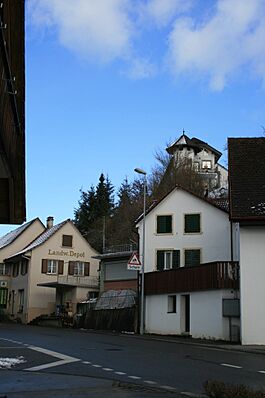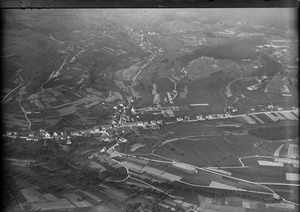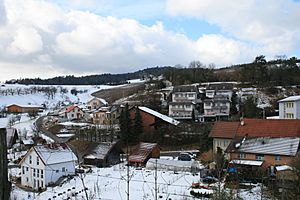Elfingen facts for kids
Quick facts for kids
Elfingen
|
||
|---|---|---|
 |
||
|
||
| Country | Switzerland | |
| Canton | Aargau | |
| District | Laufenberg | |
| Area | ||
| • Total | 4.23 km2 (1.63 sq mi) | |
| Elevation | 457 m (1,499 ft) | |
| Population
(December 2020)
|
||
| • Total | 298 | |
| • Density | 70.45/km2 (182.5/sq mi) | |
| Postal code |
5077
|
|
| Surrounded by | Bözen, Effingen, Hornussen, Mönthal, Sulz | |
Elfingen was a small town, or municipality, in Switzerland. It was located in the Aargau region, in an area called Laufenberg.
On January 1, 2022, Elfingen joined with three other nearby towns. These were Bözen, Effingen, and Hornussen. Together, they formed a new, larger town called Böztal.
Contents
A Look Back at Elfingen's History
Elfingen has a long history. People found old graves from the Alamanni people there. This shows that people lived in the area as early as the 600s.
The town was first officially mentioned in the year 1245. Back then, it was called Eolfingen. For a long time, it was owned by a powerful abbey (a type of monastery) called Murbach Abbey.
In 1291, the Murbach Abbey sold its lands in Aargau. Elfingen became part of the lands owned by the Habsburg family. Later, in 1460, Elfingen came under the control of Bern, another important Swiss city.
The local Catholic church was built in 1323. It was named after St. Leodegar. Over time, the main church office moved to the nearby town of Bözen. However, the priest's house stayed in Elfingen until 1824. Elfingen also had its own school by 1720.
For many years, farming was the main way people made a living in Elfingen. They especially raised animals. In the 1700s, some people also started spinning cotton at home to earn extra money. Even in 2000, many people in Elfingen still worked in farming.
Where Elfingen Was Located
Elfingen was a small place, covering about 4.23 square kilometers (about 1.6 square miles).
Most of the land in Elfingen was either used for farming or covered by forests.
- About 45.9% of the land was used for farming.
- About 49.4% was covered by forests.
- Only a small part, about 3.8%, had buildings or roads.
The town was nestled in a valley within the Jura plateau. It included the main village of Elfingen and some smaller areas called hamlets.
Elfingen's Coat of Arms
The coat of arms for Elfingen was red. It had a special silver cross with wide ends. This cross looked like it was growing out of three green hills at the bottom.
This cross came from the coat of arms of Hungary. This is because Elfingen used to belong to a place called Königsfelden Abbey. This Abbey was started by Queen Agnes of Hungary.
People in Elfingen
Elfingen was a small community. As of 2020, it had a population of 296 people.
Over the years, the number of people living in Elfingen changed. For example, between 1997 and 2007, the population grew by about 11%.
Most people in Elfingen spoke German, which is the main language in that part of Switzerland. A smaller number of people spoke Portuguese or Serbo-Croatian.
The town had a mix of ages:
- About 9.1% of the people were young children (0-9 years old).
- About 8.7% were teenagers (10-19 years old).
- The rest were adults and older people.
Many people in Elfingen owned their homes. In 2000, about 74.4% of homes were owned by the people living in them.
Most people in Switzerland get a good education. In Elfingen, about 74% of adults (aged 25-64) had finished high school or gone on to higher education like university. In the 2008/2009 school year, 17 students attended primary school in the town.
Here's how the population of Elfingen changed over time:
| Historical population | ||
|---|---|---|
| Year | Pop. | ±% |
| 1764 | 144 | — |
| 1850 | 265 | +84.0% |
| 1900 | 217 | −18.1% |
| 1950 | 199 | −8.3% |
| 1980 | 165 | −17.1% |
| 2000 | 240 | +45.5% |
Economy and Jobs
In 2007, Elfingen had a very low unemployment rate, only 0.91%. This means almost everyone who wanted a job had one.
Most jobs in Elfingen were in farming. In 2005, 33 people worked in farming, and there were 12 farming businesses. There were also a few jobs in other areas, like manufacturing and services.
Many people who lived in Elfingen worked outside the town. In 2000, about 76.4% of workers traveled to other towns for their jobs. Only a small number of people (13) came into Elfingen to work.
For getting to work, about 15.1% of people used public transportation. A larger number, 50.8%, used their own cars.
Religion in Elfingen
According to a survey in 2000:
- About 21.3% of the people were Roman Catholic.
- About 58.3% belonged to the Swiss Reformed Church (a type of Protestant church).
Things to See
The village of Elfingen is recognized as an important part of Swiss heritage. This means it has special historical or cultural value.
See also
 In Spanish: Elfingen para niños
In Spanish: Elfingen para niños







